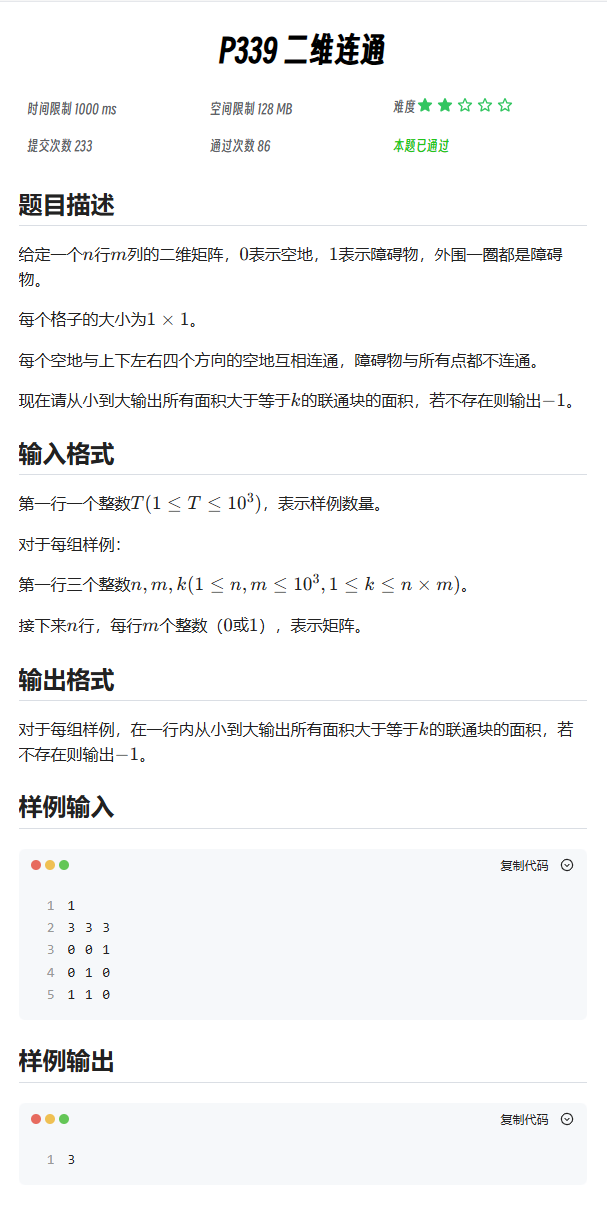一、题目

二、题解:
2.1:由题目得出,此题为类迷宫问题,因此我们可以考虑DFS/BFS
- 假如使用DFS来解决问题,可以得出时间复杂度为 O ( n ∗ m ) O(n*m) O(n∗m),且 ( 1 ≤ n , m ≤ 1 0 3 ) (1≤n,m≤10 ^3) (1≤n,m≤103),因此时间复杂度大致为 1 e 9 1e9 1e9,可以解决问题
- BFS同理,一样为 1 e 9 1e9 1e9
2.2:首先,让我们来用DFS来解决问题
1、因为题目要求我们按照升序来进行答案的输出,因此我们可以考虑使用 s e t ( ) set() set()函数/使用(vector+sort)
2、在迷宫问题中,我们需要考虑不能重复访问同一块区域的问题,因此我们使用st[N]数组来表示某个点是否范围过
const int N = 1007;
int g[N][N];
bool st[N][N];
int n,m,k;
set<int>res;
3、样例的输入:应当是访问到合理的区局块时(如果[x][y]没有被走过,并且可以走),才开始计算面积,也就是才开始调用DFS函数来进行这个区域的覆盖+面积计算
for(int i=1;i<=n;i++){for(int j=1;j<=m;j++){ if(st[i][j]==false && g[i][j]==0) {int cnt=dfs(i,j);if(cnt>=k) res.insert(cnt);} }}
4、DFS函数
- 1):因为我们需要计算一整块的面积总和(每一块洪水区域的方块总和)因此需要使用
int型的DFS递归函数 - 2):在每一次DFS的递归过程中,我们一直往下递,直到访问到了非法的边界,就开始归
(return) 一步步求出总的面积和,最后返回递归的总和即可
int dx[]={0,1,0,-1};
int dy[]={1,0,-1,0};
int dfs(int x,int y)
{int temp=1; st[x][y]=true; for(int i=0;i<4;i++) {int a=x+dx[i],b=y+dy[i];if(a<1 || a>n || b<1 || b>m) continue; if(st[a][b]==true) continue; if(g[a][b]==1) continue; temp+=dfs(a,b); }return temp;
}
5、注意题目中有多个样例,因此在每一轮的样例中,都要清空状态数组st和答案数组set<int>res
res.clear();
memset(st,0,sizeof(st));
三、完整代码
#include<bits/stdc++.h>
using namespace std;const int N = 1007;
int g[N][N];
bool st[N][N];
int n,m,k;
set<int>res; int dx[]={0,1,0,-1};
int dy[]={1,0,-1,0};int dfs(int x,int y)
{int temp=1; st[x][y]=true; for(int i=0;i<4;i++) {int a=x+dx[i],b=y+dy[i];if(a<1 || a>n || b<1 || b>m) continue; if(st[a][b]==true) continue; if(g[a][b]==1) continue; temp+=dfs(a,b); }return temp;
}void solve()
{res.clear();memset(st,0,sizeof(st));cin>>n>>m>>k;for(int i=1;i<=n;i++){for(int j=1;j<=m;j++){cin>>g[i][j];}}for(int i=1;i<=n;i++){for(int j=1;j<=m;j++){ if(st[i][j]==false && g[i][j]==0) {int cnt=dfs(i,j);if(cnt>=k) res.insert(cnt);} }}if(res.empty()) {cout<<-1<<'\n';return ;}for(auto i:res){cout<<i<<' ';}
}int main() {ios::sync_with_stdio(0), cin.tie(0), cout.tie(0);int _ = 1;cin>>_;while (_--) solve();return 0;
}



)
感知机)


